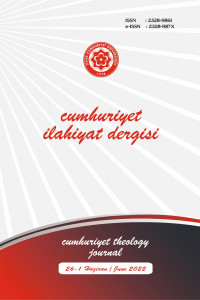Fıkhî Açıdan Atıksuların Arıtılabilirliği
Treatability of Wastewater from the Aspect of Islamic Law
Author(s): Hüseyin BaysaSubject(s): Health and medicine and law, Human Ecology, Sharia Law
Published by: Cumhuriyet Üniversitesi İlahyat Fakültesi
Keywords: Islamic Law; Treated Wastewater; Treatment Methods; Clean Water Criteria; Water Scarcity;
Summary/Abstract: The lack of water, has become a global problem caused by climate change, waste, and misuse of water. The reuse of wastewater is considered an important solution to overcome this problem. The provision of the Sharīʿah on treated wastewater is important in this respect. Although the criteria for clean water are given in the religious texts, there is no information directly related to the purification of polluted water. The legal scholars have determined some criterion and methods for the purification of water exposed to najāsat (filthy things) based on the criteria what clean water is. These are the interventions carried out in the form of throwing substances such as soil and lime into the water, increasing the amount of water (mukātharat), or decreasing it. The aim of these applications is to rectify the change in the color, taste, or smell of the water due to pollution. As a matter of fact, since it fulfills the same purpose, the natural recovery of the aforementioned qualities over time has also been accepted as a method of cleansing. The Ḥanafis, unlike the majority of the fuqaha, by being cautious, only allowed from these the techniques of mukātharat and water reduction. These methods and techniques were developed for the cleaning of water exposed to najāsat, but these are not applicable to the treatment of wastewater that contains intensely najis elements. Today, wastewater is treated at different levels according to their usage areas, with systems that have a logic similar to traditional methods but different from them structurally. In this study, the sharʿī judgment of wastewater treated with today's technology has been investigated. Due to the limitation of this research, the provisions regarding the usage areas of treated wastewater are left out. In the ḥadīths related to this particular subject, physical properties are determined as the basic measure for the cleanliness level of water. Although najis substances do not penetrate the chemistry of the water, depending on their nature and amount they reflect their physical properties to the water. The degree of effect of najāsat can be detected from the color, taste and smell leaving on the water. In relation to this, it can be said that by setting the physical properties as the primary criterion for judging water, it is actually intended to determine the level of depuration from najis substances. From these criterion, it can be seen that the level of conformity of water to human health is considered the upper target. In that case, the sharʿī judgment on treated wastewater depends on the physical qualities of the water, whether it contains impure elements and its level of healthfulness. Since the wastewater is subjected to a rough separation in the first of the treatments carried out today, najis substances continue to exist in the water. For this reason, the color, taste and smell of the pollutants reflected in the water also preserve their existence. In secondary treatment, wastewater is largely cleaned of organic pollutants. However, there is no complete improvement in the color, taste and smell of the water. In the tertiary (advanced) treatment, the water is completely cleaned of organic pollutants, and therefore, the physical anomalies in the water caused by the pollutants are also eliminated. According to this, the water passed through advanced treatment meets the condition of being ṭāhir (clean). However, since advanced treatment is a process that covers different applications, if the treatment is limited to certain applications, some chemical pollutants such as endocrine disruptors and antibiotics may still exist in the water albeit in very small quantities. For this reason, the water used in sensitive areas must be completely free of contaminants harmful to health.
Journal: Cumhuriyet İlahiyat Dergisi
- Issue Year: 26/2022
- Issue No: 1
- Page Range: 415-432
- Page Count: 18
- Language: Turkish

